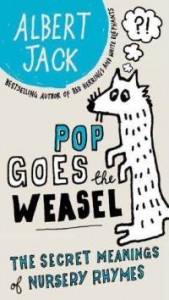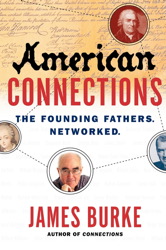
I recently finished two books that took different and interesting approaches of presenting history. The first, Pop Goes the Weasel by Albert Jack, uses nursery rhymes as a guide through British history. Actually, the intention is to delve into the origins of the very common nursery rhymes we all learn and subsequently teach our children. But, given that so many of them are rooted in historical fact, it ends up being quite the whirlwind tour of history.
For example, Humpty Dumpty was a cannon used in the English Civil War in the mid 1600s. It was used to great effect to keep the Parliamentarians at bay, until the tower it was housed in was destroyed, sending Humpty to the ground, where it was useless. Or Baa Baa, Black Sheep being about a tax on wool, where, as is typical, the working class got stiffed in favor of the business owner and the church. Or the Three Blind Mice being three bishops upon whom Queen Mary I took revenge when she ascended to the throne for their role in persecuting Catholicism during Edward VI’s reign.
The book is written such that the story behind each rhyme is independent of the others. As such, some of the style does get a little tedious, as Jack introduces each one in a way to try to pique the reader’s interest that becomes repetitive. But, as a reference, it is a great way to organize things as you can easily go back and reread about any given rhyme with ease. Not all of the origins of these rhymes are overly convincing, as Jack himself points out as he explores alternative theories about each one. My only real issue, however, is that there are no references or citations that document where the theories came from.
Not being a British history buff, I still enjoyed learning about all of these dark episodes in British history (as it does seem most of these seemingly innocent rhymes have their origins in the dark recesses of regicide or other equally murderous plots. It does make me wonder how differently the book could have read if the rhymes were used specifically as tools to guide us through British history.
 Which brings me to the second book, American Connections by James Burke. I first encountered Burke during my first year as a Vandal. If you’ve never been exposed to his unique approach to history, Burke draws connections between people and things to highlight the links between them, the interconnectedness of the people, events, and inventions that drive history. In American Connections, he uses the Founding Fathers — all of the signers of the Declaration of Independence — to make connections through history to our own times. As an example, take Thomas Jefferson –> Cesare Beccaria –> Jean-Baptiste Joseph Delambre –> James Macie –> David Brewster –> Dr. John Bostock –> Dr. John Elliotson –> Dr. James Esdaile –> Karl von Reichenback –> Gustav Fechner –> Ernst Mach –> Wilhelm Ostwald –> William Ramsay –> Harold Edgerton –> Jacques Cousteau –> side-scan sonar –> USNS Littlehales –> National Oceanic and Atmospheric Administration –> Littlehales renamed Thomas Jefferson (if you are interested in what all of these people have in connection, you’ll have to read the book).
Which brings me to the second book, American Connections by James Burke. I first encountered Burke during my first year as a Vandal. If you’ve never been exposed to his unique approach to history, Burke draws connections between people and things to highlight the links between them, the interconnectedness of the people, events, and inventions that drive history. In American Connections, he uses the Founding Fathers — all of the signers of the Declaration of Independence — to make connections through history to our own times. As an example, take Thomas Jefferson –> Cesare Beccaria –> Jean-Baptiste Joseph Delambre –> James Macie –> David Brewster –> Dr. John Bostock –> Dr. John Elliotson –> Dr. James Esdaile –> Karl von Reichenback –> Gustav Fechner –> Ernst Mach –> Wilhelm Ostwald –> William Ramsay –> Harold Edgerton –> Jacques Cousteau –> side-scan sonar –> USNS Littlehales –> National Oceanic and Atmospheric Administration –> Littlehales renamed Thomas Jefferson (if you are interested in what all of these people have in connection, you’ll have to read the book).
Burke does an admirable job of taking us from 1776 to our modern times through these connections. Along the way, he makes some interesting observations about society at the time and the progress of, for example, scientific knowledge (people like Mach and Ostwald were very important for several branches of science). As he goes through the chains of people connecting one another, he has an odd fascination with their sexual behaviors. Besides making it clear which were homosexual (possibly to highlight the role that homosexuals have had in history?), he also touches on people who had very let’s say active sex lives, with many loves. I wonder if this is because he thought it would spice up the story (which it certainly does, at it seems everyone was engaging in three- or foursomes or were nymphomaniacs) or if it was simply easier to connect people with others through these “hubs”, these people who knew (in more ways than one) so many others. I suspect it is a bit of both.
Near the end of each chapter (focused on a different signer), it felt like Burke copped out a bit by connecting to some big corporation or some big organization and finding someone who worked for that group as his final link. It just felt like he stalled a bit, not finding anything more direct. It also felt like something that he could always do to make that final link, it was just a question of how long he wanted to go until he got there. However, it is a minor quibble.
Overall, his approach is a very entertaining one through American and British history. Not that I would retain much, as names and places are thrown about with abandon, but the overall richness stays with you.